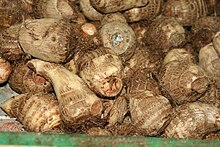Emergence of agriculture in the Philippines
[8] With the Austronesian language family and its dispersal in mind, Peter Bellwood and Colin Renfrew proposed one of the first ideas highlighting the origin of agriculture in Island Southeast Asia.
[8] Bellwood and Renfrew argued that, because of agriculture, the Austronesian speaking people migrated from their homeland in Taiwan to the Philippines and Indo-Malaysia then reached the Pacific after passing New Guinea.
[8][3] The vocabulary is used as evidence for agriculture being the driving force behind the migration because it includes words like rice, millet, and pigs that are very similar across languages in Island Southeast Asia.
[8] It is believed that rice-based agriculture allowed Austronesian speaking people to migrate to regions inhabited by hunter-gatherers and populate the area or replace them to a degree.
[2][4][9][10] Tim Denham, a university professor of anthropology, author, and research fellow, argued that there is not enough archaeological evidence to support the use of agriculture in ISEA before 3,000 years ago.
[4] Using multidisciplinary evidence, including the origin and spread of plant and animal domesticates in Island Southeast Asia, Denham proposed that East Asian crops are found in ISEA, but only after the period of Austronesian-speaking peoples' expansion.
[2] The idea that Neolithic expansion in Island Southeast Asia did not involve farming practices was described by Matthew Spriggs, an active voice in this archaeological topic.
[9] Material culture of this epoch such as the red-slipped pottery marks the fusion of different social groups including migrants from outside of these islands as well as individuals already situated in the area.
[10] He emphasizes the idea that complex societies did not have to involve sedentary farming practices and that hunting and foraging could have been the main provider for subsistence.
[5] They most likely kept a relationship between neighboring communities to hunt in order to obtain their protein, while at the same time clearing land to grow their crops.
[11] Previous models about the emergence of agriculture in ISEA credit the Austronesian dispersal for the introduction of taro and rice in those regions.
[11] However, new evidence exhibits that taro has pan-Southeast Asian origins and can be traced much earlier than the spread of Austronesian-speaking peoples in the region of Luzon in the Philippines.
[11] According to anthropologist Victor Paz, among the archaeological research done in the Philippines there has not been enough concrete evidence to point towards an early presence of rice agriculture.
[6] Tim Denham and Mark Donohue dismiss the idea that this evidence could be related to early intensive agriculture and instead conclude that the carbonized rice inclusions could be associated with foreign trade.
[7] Because of this, it is believed that rice was reserved for only the chiefs or elite members of the tribe and was a main factor in establishing social stratification and geographic differentiation.



